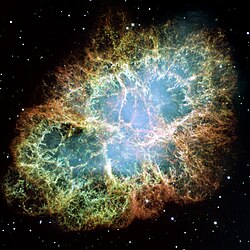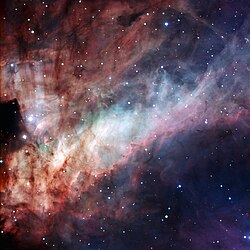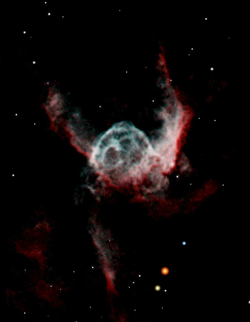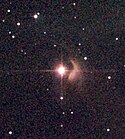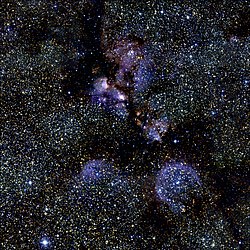Sharplessův katalog
Sharplessův katalog je astronomický katalog 313 oblastí HII (tedy emisních mlhovin), který byl zamýšlen jako ucelený souhrn těchto objektů severně od deklinace −27°. Navíc obsahuje i několik mlhovin jižně od této deklinace. První vydání obsahující 142 objektů zveřejnil americký astronom Stewart Sharpless v roce 1953 (označovaly se Sh1) a druhé závěrečné vydání s 313 objekty zveřejnil v roce 1959.[1] Katalog obsahuje kromě oblastí HII také několik planetárních mlhovin a pozůstatků supernov.[2]
V roce 1953 se Stewart Sharpless stal pracovníkem astronomické observatoře United States Naval Observatory Flagstaff Station v Arizoně,[3] kde na snímcích z přehlídky oblohy s názvem Palomar Observatory Sky Survey (POSS) soustavně zkoumal a sepisoval oblasti HII v Mléčné dráze. Na základě tohoto průzkumu sestavil svůj katalog, který vyšel ve dvou vydáních: první vyšlo v roce 1953 a obsahovalo 142 mlhovin,[4] druhé pak vyšlo v roce 1959 a zahrnovalo 313 mlhovin.[1]
Souřadnice objektů v katalogu se opírají o katalogy Bonner Durchmusterung (BD) a Cordoba Durchmusterung (CD), ale přestože byly souřadnice ve druhém vydání přepočteny na jednotné ekvinokcium 1900, nevzal Sharpless v potaz časovou prodlevu mezi vznikem obou zdrojových katalogů a souřadnice mnoha jižních mlhovin tak obsahují významnou odchylku přesahující jednu úhlovou minutu.[2] Tuto chybu z katalogu odstranili Leo Blitz, Michel Fich a Antony Stark v roce 1982.[2][5] Zároveň z katalogu odstranili planetární mlhoviny a pozůstatky supernov a přidali další objevené oblasti HII.[2][5]
Některé z položek Sharplessova katalogu se vyskytují i v Messierově katalogu, NGC katalogu, Caldwellově katalogu nebo RCW katalogu. Ze stejné doby pochází i Gumův katalog a RCW katalog, ale ty se zabývaly převážně objekty na jižní obloze.
Příklady
Následující tabulka ukazuje příklad objektů z druhého vydání Sharplessova katalogu (1959). Kliknutím na náhled obrázku se zobrazí větší obrázek a původ obrázku (většinou různí amatérští fotografové nebo ESO, ESA či NASA).
| Sh2 číslo | Běžné jméno | Obrázek | Další jména a poznámky |
|---|---|---|---|
| 6 | NGC 6302 |  | Sh2-6, NGC 6302, Bug Nebula, PK 349+01 1, Butterfly Nebula, RCW 124, Gum 60, Caldwell 69 |
| 8 | NGC 6334 |  | Sh2-8, NGC 6334, ESO 392-EN 009, RCW 127, Gum 64 |
| 11 | NGC 6357 |  | Sh2-11, NGC 6357, RCW 131, Gum 66, mlhovina Válka a mír |
| 25 | Mlhovina Laguna |  | Sh2-25, Messier 8, RCW 146, Gum 72 |
| 29 | Sh2-29 |  | Sh2-29 |
| 30 | Mlhovina Trifid |  | Sh2-30, M20, NGC 6514, RCW 147, Gum 76 |
| 45 | Mlhovina Omega |  | Sh2-45, M17, NGC 6618, Swan Nebula, Omega Nebula, RCW 160, Gum 81 |
| 49 | Orlí mlhovina |  | Sh2-49, M16, NGC 6611, RCW 165, Gum 83 |
| 64 | Westerhout 40 (W 40) |  | Sh2-64, RCW 174 |
| 101 | Sh2-101 |  | Sh2-101, Tulip Nebula |
| 105 | NGC 6888 |  | Sh2-105, NGC 6888, Caldwell 27, Crescent Nebula |
| 106 | Sh2-106 | (c) NASA & ESA, CC BY 4.0 | Sh2-106, Celestial Snow Angel |
| 117 | Mlhovina Severní Amerika |  | Sh2-117, NGC 7000, Caldwell 20 |
| 125 | Mlhovina Kokon |  | Sh2-125, IC 5146, Caldwell 19 |
| 140 | Sh2-140 |  | Sh2-140 |
| 155 | Sh2-155 |  | Sh2-155, Caldwell 9, Cave Nebula |
| 162 | NGC 7635 |  | Sh2-162, NGC 7635, Bubble nebula |
| 184 | NGC 281 |  | Sh2-184, NGC 281, IC 11 |
| 190 | Mlhovina Srdce |  | Sh2-190, IC 1805 |
| 191 | Maffei I |  | Sh2-191, Maffei 1, PGC 9892 |
| 197 | Maffei II |  | Sh2-197, Maffei 2, UGCA 39,[6]PGC 10217,[6] |
| 199 | Mlhovina Duše |  | Sh2-199, LBN 667, Soul Nebula, IC 1848 (pouze hvězdokupa) |
| 220 | Mlhovina Kalifornie |  | Sh2-220, NGC 1499 |
| 229 | IC 405 |  | Sh2-229, Flaming Star Nebula, Caldwell 31, IC 405 |
| 237 | NGC 1931 |  | Sh2-237 |
| 238 | NGC 1555 |  | Sh2-238, NGC 1555, Hind's Nebula |
| 244 | Krabí mlhovina |  | Sh2-244, Messier 1, NGC 1952 |
| 248 | IC 443 |  | Sh2-248, IC 443, Jellyfish Nebula |
| 273 | NGC 2264 |  | Sh2-273, NGC 2264 |
| 275 | NGC 2237 |  | Sh2-275, CTB 21, Rosette Nebula, Mlhovina Rozeta |
| 276 | Barnardova smyčka |  | Sh2-276, Barnard's Loop |
| 277 | Mlhovina Plamínek |  | Sh2-277, NGC 2024 |
| 279 | Sh2-279 |  | Sh2-279 |
| 281 | Mlhovina v Orionu |  | Sh2-281, M42, NGC 1976, LBN 974 |
| 297 | Sh2-297 |  | Sh2-297, Ced 90, LBN 1039 |
| 298 | NGC 2359 |  | Sh2-298, Thorova helma, Thor's Helmet, Gum 4, Sh2-298, NGC 2359 |
Reference
V tomto článku byl použit překlad textu z článku Sharpless catalog na anglické Wikipedii.
- ↑ a b SHARPLESS, Stewart. A Catalogue of H II Regions. S. 257. Astrophysical Journal Supplement [online]. Prosinec 1959 [cit. 2019-09-18]. Roč. 4, s. 257. Dostupné online. Bibcode 1959ApJS....4..257S. (anglicky)
- ↑ a b c d The Gum, RCW, Sharpless and BFS catalogs [online]. [cit. 2019-09-18]. Dostupné online. (anglicky)
- ↑ DICK, Steven. Sky and Ocean Joined: The U.S. Naval Observatory, 1830–2000. [s.l.]: Cambridge University Press, 2002. Dostupné online. ISBN 978-0-521-81599-4.
- ↑ SHARPLESS, Stewart. A Catalogue of Emission Nebulae Near the Galactic Plane. S. 362. Astrophysical Journal [online]. Listopad 1953 [cit. 2019-09-19]. Roč. 118, s. 362. Dostupné online. Bibcode 1953ApJ...118..362S. (anglicky)
- ↑ a b BLITZ, Leo; FICH, Michel; STARK, Antony. Catalogue of CO radial velocities toward galactic HII regions. S. 183–206. Astrophysical Journal Supplement [online]. Červen 1982 [cit. 2019-09-19]. Roč. 49, s. 183–206. Dostupné online. Bibcode 1982ApJS...49..183B. (anglicky)
- ↑ a b NASA/IPAC Extragalactic Database: Results for Maffei 2 [online]. [cit. 2019-09-19]. Dostupné online. (anglicky)
Související články
Externí odkazy
 Obrázky, zvuky či videa k tématu Sharplessův katalog na Wikimedia Commons
Obrázky, zvuky či videa k tématu Sharplessův katalog na Wikimedia Commons - The Gum, RCW, Sharpless and BFS catalogs [online]. [cit. 2019-09-18]. Dostupné online. (anglicky)
- SIMBAD Astronomical Database: Results for 1959ApJS....4..257S [online]. [cit. 2019-08-19]. Dostupné online. (anglicky)
- SALMAN, Dean. The best of Sharpless catalog [online]. [cit. 2019-09-19]. Dostupné online. (anglicky)
Média použitá na této stránce
Autor: Oliver Stein, Licence: CC BY-SA 3.0
Sulla sinistra NGC 1499, la Nebulosa California.
Fotografia di Oliver Stein.
Autor: Adam Block/Mount Lemmon SkyCenter/University of Arizona, Licence: CC BY-SA 3.0
Cederblad 90, vdB 94, Gum 3, Sh2-297
Picture Details: Optics 32-inch Schulman Telescope (RC Optical Systems) Camera SBIG STX 16803 CCD Camera Filters AstroDon Gen II Dates October 2011 Location Mount Lemmon SkyCenter Exposure LRGB = 320:160:140:120 minutes Acquisition ACP Observatory Control Software (DC-3 Dreams),TheSky (Software Bisque), Maxim DL/CCD (Cyanogen)
Processing CCDStack (CCDWare), Photoshop CS5 (Adobe)This is a mosaic image, one of the largest ever taken by NASA's Hubble Space Telescope, of the Crab Nebula, a six-light-year-wide expanding remnant of a star's supernova explosion. Japanese and Chinese astronomers recorded this violent event in 1054 CE.
The orange filaments are the tattered remains of the star and consist mostly of hydrogen. The rapidly spinning neutron star embedded in the center of the nebula is the dynamo powering the nebula's eerie interior bluish glow. The blue light comes from electrons whirling at nearly the speed of light around magnetic field lines from the neutron star. The neutron star, like a lighthouse, ejects twin beams of radiation that appear to pulse 30 times a second due to the neutron star's rotation. A neutron star is the crushed ultra-dense core of the exploded star.
The Crab Nebula derived its name from its appearance in a drawing made by Irish astronomer Lord Rosse in 1844, using a 36-inch telescope. When viewed by Hubble, as well as by large ground-based telescopes such as the European Southern Observatory's Very Large Telescope, the Crab Nebula takes on a more detailed appearance that yields clues into the spectacular demise of a star, 6,500 light-years away.
The newly composed image was assembled from 24 individual Wide Field and Planetary Camera 2 exposures taken in October 1999, January 2000, and December 2000. The colors in the image indicate the different elements that were expelled during the explosion. Blue in the filaments in the outer part of the nebula represents neutral oxygen, green is singly-ionized sulfur, and red indicates doubly-ionized oxygen.From the source site, courtesy of NASA/JPL-Caltech: Generations of stars can be seen in this new infrared portrait from NASA's Spitzer Space Telescope. In this wispy star-forming region, called W5, the oldest stars can be seen as blue dots in the centers of the two hollow cavities (other blue dots are background and foreground stars not associated with the region). Younger stars line the rims of the cavities, and some can be seen as pink dots at the tips of the elephant-trunk-like pillars. The white knotty areas are where the youngest stars are forming. Red shows heated dust that pervades the region's cavities, while green highlights dense clouds.
W5 spans an area of sky equivalent to four full moons and is about 6,500 light-years away in the constellation Cassiopeia. The Spitzer picture was taken over a period of 24 hours.
Like other massive star-forming regions, such as Orion and Carina, W5 contains large cavities that were carved out by radiation and winds from the region's most massive stars. According to the theory of triggered star-formation, the carving out of these cavities pushes gas together, causing it to ignite into successive generations of new stars.
This image contains some of the best evidence yet for the triggered star-formation theory. Scientists analyzing the photo have been able to show that the ages of the stars become progressively and systematically younger with distance from the center of the cavities.
Autor: Původně soubor načetl Abdelqader na projektu Wikipedie v jazyce angličtina, Licence: CC BY-SA 3.0
IC 443 wide field image. The stars η (right) and μ (left) Geminorum, the diffuse emission from S249 (north), and the G189.6+3.3 partial shell (center) are visible.
(c) NASA & ESA, CC BY 4.0
This image from the NASA/ESA Hubble Space Telescope shows Sh 2-106, or S106 for short. This is a compact star forming region in the constellation Cygnus (The Swan). A newly-formed star called S106 IR is shrouded in dust at the center of the image, and is responsible for the surrounding gas cloud’s hourglass-like shape and the turbulence visible within. Light from glowing hydrogen is colored blue in this image.
Autor: Hewholooks, Licence: CC BY-SA 3.0
IC 405 - The "Flaming Star Nebula"
SBIG ST-4000XCM 15x15min Imager Temp -20C APM/TMB 130/780 Field Flattenerref. http://hwilson.zenfolio.com/emission/h3590e589#h3590e589
Spitzer IRAC mosaic of the W40 (=Sh 2-64) star-forming region. Red: 8µm; Green: 5.8µm; Blue: 3.6µm
Autor: ESO, Licence: CC BY 4.0
Three-colour composite mosaic image of the Eagle Nebula (Messier 16, or NGC 6611), based on images obtained with the Wide-Field Imager camera on the MPG/ESO 2.2-metre telescope at the La Silla Observatory. At the centre, the so-called “Pillars of Creation” can be seen. This wide-field image shows not only the central pillars, but also several others in the same star-forming region, as well as a huge number of stars in front of, in, or behind the Eagle Nebula. The cluster of bright stars to the upper right is NGC 6611, home to the massive and hot stars that illuminate the pillars. The “Spire” — another large pillar — is in the middle left of the image. This image is a composite of 3 filters in the visible range: B (blue), V (green) and R (red).
Autor: European Southern Observatory, Licence: CC BY 4.0
Three-colour composite image of the Omega Nebula (Messier 17, or NGC 6618), based on images obtained with the EMMI instrument on the ESO 3.58-metre New Technology Telescope at the La Silla Observatory. North is down and East is to the right in the image. It spans an angle equal to about one third the diameter of the Full Moon, corresponding to about 15 light-years at the distance of the Omega Nebula. The three filters used are B (blue), V ("visual", or green) and R (red).
NGC 2359
Inside the Flame Nebula - Stars are often born in clusters, in giant clouds of gas and dust. Astronomers have studied two star clusters using NASA's Chandra X-ray Observatory and infrared telescopes and the results show that the simplest ideas for the birth of these clusters cannot work, as described in our latest press release.
This composite image shows one of the clusters, NGC 2024, which is found in the center of the so-called Flame Nebula about 1,400 light years from Earth. In this image, X-rays from Chandra are seen as purple, while infrared data from NASA's Spitzer Space Telescope are colored red, green, and blue.
A study of NGC 2024 and the Orion Nebula Cluster, another region where many stars are forming, suggest that the stars on the outskirts of these clusters are older than those in the central regions. This is different from what the simplest idea of star formation predicts, where stars are born first in the center of a collapsing cloud of gas and dust when the density is large enough.
The research team developed a two-step process to make this discovery. First, they used Chandra data on the brightness of the stars in X-rays to determine their masses. Next, they found out how bright these stars were in infrared light using data from Spitzer, the 2MASS telescope, and the United Kingdom Infrared Telescope. By combining this information with theoretical models, the ages of the stars throughout the two clusters could be estimated.
According to the new results, the stars at the center of NGC 2024 were about 200,000 years old while those on the outskirts were about 1.5 million years in age. In Orion, the age spread went from 1.2 million years in the middle of the cluster to nearly 2 million years for the stars toward the edges.
Explanations for the new findings can be grouped into three broad categories. The first is that star formation is continuing to occur in the inner regions. This could have happened because the gas in the outer regions of a star-forming cloud is thinner and more diffuse than in the inner regions. Over time, if the density falls below a threshold value where it can no longer collapse to form stars, star formation will cease in the outer regions, whereas stars will continue to form in the inner regions, leading to a concentration of younger stars there.
Another suggestion is that old stars have had more time to drift away from the center of the cluster, or be kicked outward by interactions with other stars. Finally, the observations could be explained if young stars are formed in massive filaments of gas that fall toward the center of the cluster.
The combination of X-rays from Chandra and infrared data is very powerful for studying populations of young stars in this way. With telescopes that detect visible light, many stars are obscured by dust and gas in these star-forming regions, as shown in this optical image of the region.
NASA's Marshall Space Flight Center in Huntsville, Ala., manages the Chandra program for NASA's Science Mission Directorate in Washington. The Smithsonian Astrophysical Observatory in Cambridge, Mass., controls Chandra's science and flight operations.Autor: Ngc1535, Licence: CC BY-SA 4.0
Optics 32-inch Schulman Telescope (RCOS)
Camera SBIG STX16803 CCD Camera Filters Astrodon Gen II Date November - December 2015 Location Mount Lemmon SkyCenter Exposure RGB = 7 : 7 : 7 Hours Acquisition Astronomer Control Panel (ACP), Maxim DL/CCD (Cyanogen), FlatMan XL (Alnitak) Processing CCDStack, Photoshop CC, PixInsight
Credit Line & Copyright Adam Block/Mount Lemmon SkyCenter/University of ArizonaAutor: Oliver Stein, Licence: CC BY-SA 3.0
Mgławica Ameryka Północna NGC 7000; zdjęcie amatorskie
NGC 6302
Autor: European Southern Observatory/M. Kornmesser, Licence: CC BY 4.0
The OmegaCAM imager on ESO’s VLT Survey Telescope has captured this glittering view of the stellar nursery called Sharpless 29. Many astronomical phenomena can be seen in this giant image, including cosmic dust and gas clouds that reflect, absorb, and re-emit the light of hot young stars within the nebula.
Autor:
- Ngc7635.jpg: Original uploader was Vanderbei at en.wikipedia
- derivative work: Dereckson (talk)
Image of the Bubble Nebula (NGC 7635) taken by Robert J. Vanderbei (http://www.princeton.edu/~rvdb/images/NJP/ngc7635.html).
In one of the most detailed astronomical images ever produced, NASA/ESA's Hubble Space Telescope captured an unprecedented look at the Orion Nebula. ... This extensive study took 105 Hubble orbits to complete. All imaging instruments aboard the telescope were used simultaneously to study Orion. The Advanced Camera mosaic covers approximately the apparent angular size of the full moon.
Coordinates Position (RA): 5 35 9.73 Position (Dec): -5° 24' 50.32" Field of view: 30.03 x 30.03 arcminutes Orientation: North is 0.0° left of vertical
Colours & filter Band Wavelength Telescope Optical B 435 nm Hubble Space Telescope ACS Optical V 555 nm Hubble Space Telescope ACS Optical H-alpha 658 nm Hubble Space Telescope ACS Infrared I 775 nm Hubble Space Telescope ACS Infrared Z 850 nm Hubble Space Telescope ACSNotes: Additional observational data from the WFI instrument on the ESO.MPG 2.2-metre telescope.
Autor: Chuck Ayoub, Licence: CC BY-SA 4.0
This picture contains Sh2-101 (the Tulip Nebula). It was created by putting Ha in the Red channel and OIII in Green and Blue channels.
Target:
Sh2-101 (Tulip)
Imaging Telescope:
Orion ED80T CF (480 focal length)
Mount:
Celestron CGX
Polar Alignment:
QHYCCD PoleMaster
Imaging Camera:
ZWO ASI1600MM-Cool
Filters:
Ha=82x180s
OIII=43x180s
Total Exposure Time: 6.2 hours
Gain: 139, Offset: 21
Guide scope:
Orion ST80
Guide Camera:
Lodestar X2
Guide Software:
PHD2
Calibration Frames:
Darks: 50, Bias: 50, Flats: 50
Capture software:
Sequence Generator Pro (SGP)
Stacking software:
DeepSkyStacker
Post Processing:
PixInsight, PhotoShop
Autor: Hewholooks, Licence: CC BY-SA 3.0
Barnard's Loop Taken with Canon 350D and 70-200L Lens. RGB and Hydrogen alpha light.
NGC 6334 "Cat's Paw Nebula", Scorpius Constellation
Autor: Giuseppe Donatiello, Licence: CC0
Fox Fur Nebula Credit: DSS / Giuseppe Donatiello Fox Fur Nebula is a nebula located in Monoceros and included in the NGC 2264 Region. The red colors of this nebula are caused by hydrogen gas that has been stimulated to emit its own light by the copious ultraviolet radiation coming from the hot, blue stars of the cluster. The blue areas are mainly dust clouds that reflect the bluish light of the same stars.
The nebula looks like the head of a stole made from the fur of a red fox.Autor: Hewholooks, Licence: CC BY-SA 3.0
Amateur image of IC5146 - Cocoon Nebula in Cygnus
Rosette nebula. Original text: (from en.wikipedia) These images are released into the public domain for private use or for use in the promotion of the IPHAS survey. If any image or images are redisplayed or reproduced, please accompany the image or images with the following acknowledgement: "Image based on data obtained as part of the INT Photometric H-Alpha Survey of the Northern Galactic Plane, prepared by Nick Wright, University College London, on behalf of the IPHAS Collaboration".
Description: This image of the Rosette Nebula (NGC 2237) is thought to be the most-detailed ever produced. Compiled from data taken from IPHAS, the Isaac Newton Telescope Photometric Hydrogen-Alpha Survey of the Northern Galactic Plane, the image spans four square degrees, about twenty times the size of the full moon. Resolution is 1 arcsecond per pixel, and North is up, east is left.
Technical information: Telescope: 2.5-m Isaac Newton Telescope.
Instrument: Wide Field Camera.
Detector: EEV.
Maffei 1 (UGCA 34) elliptical galaxy
Hvězdokupa NGC 6357 (Pismis 24) v jádru velké emisní mlhoviny NGC 6334 v souhvězdí Štíra Část mlhoviny je ionizována nejmladší těžkou hvězdou v Pismis 24 a vzniká tak velmi intenzivní ultafialové záření.
Autor: Hewholooks, Licence: CC BY-SA 3.0
NGC 1931 Difuse nebula and cluster taken with Celestron 9.25 and Modified Canon 350D



